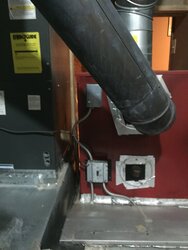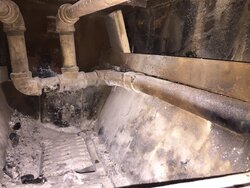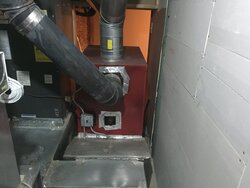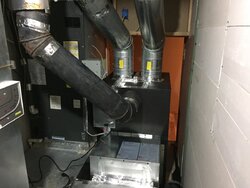Everything Drolet Tundra - Heatmax...
- Thread starter brenndatomu
- Start date
-
Active since 1995, Hearth.com is THE place on the internet for free information and advice about wood stoves, pellet stoves and other energy saving equipment.
We strive to provide opinions, articles, discussions and history related to Hearth Products and in a more general sense, energy issues.
We promote the EFFICIENT, RESPONSIBLE, CLEAN and SAFE use of all fuels, whether renewable or fossil.
You are using an out of date browser. It may not display this or other websites correctly.
You should upgrade or use an alternative browser.
You should upgrade or use an alternative browser.
TDD11
Member
Hi Everyone,
I'm new here. I've read the entire thread. I have spent my entire life with wood heat, so I am familiar, but reading this thread made me feel clueless. There's definitely a lot of information in this thread to absorb.
With my new house, I hope to upgrade the older Jotul F118 that the previous owner left, and I'm considering the original Tundra. I want to upgrade to a stove with a blower in order to get that heat out of the basement and into the upstairs.
Right now, I can a brand new (old stock display model, built in 10/2013) Tundra 1 for $1000 after mail in rebates and sales tax.
My house is a brick 2 story, roughly 1600 square feet total - which includes the finished basement where the furnace would reside.
The chimney runs up through the center of the house, and it is a clay liner. Draft doesn't seem to be an issue with my current stove, I haven't measured it though.
As far as ventilation goes, I would plumb the 2 8" vents from the stove into the furnace duct that is directly above the stove, which has 3-4 registers on the ground level. There is no active heating of the 2nd floor, only through convection via an open staircase from the ground floor living room to the 2nd floor.
I think this stove will be plenty hot, but I'm almost concerned that it will be too much stove. Granted some day I plan to do an addtion but that may be 5 years down the road.
Thoughts? I'm located in central Ohio. I like some of the controls you guys have developed, and would want to replicate someone's setup.
I'm new here. I've read the entire thread. I have spent my entire life with wood heat, so I am familiar, but reading this thread made me feel clueless. There's definitely a lot of information in this thread to absorb.
With my new house, I hope to upgrade the older Jotul F118 that the previous owner left, and I'm considering the original Tundra. I want to upgrade to a stove with a blower in order to get that heat out of the basement and into the upstairs.
Right now, I can a brand new (old stock display model, built in 10/2013) Tundra 1 for $1000 after mail in rebates and sales tax.
My house is a brick 2 story, roughly 1600 square feet total - which includes the finished basement where the furnace would reside.
The chimney runs up through the center of the house, and it is a clay liner. Draft doesn't seem to be an issue with my current stove, I haven't measured it though.
As far as ventilation goes, I would plumb the 2 8" vents from the stove into the furnace duct that is directly above the stove, which has 3-4 registers on the ground level. There is no active heating of the 2nd floor, only through convection via an open staircase from the ground floor living room to the 2nd floor.
I think this stove will be plenty hot, but I'm almost concerned that it will be too much stove. Granted some day I plan to do an addtion but that may be 5 years down the road.
Thoughts? I'm located in central Ohio. I like some of the controls you guys have developed, and would want to replicate someone's setup.
DoubleB
Minister of Fire
Welcome to hearth, TDD11!
I think the Tundra can heat more than your house if needed, but you don't need to redline it and it sounds like your house is a good size. The Tundra will simmer for a long time in a smaller house and is more efficient that way.
I put in a few large 1st floor registers dedicated to the Tundra. The upstairs was a good 10F colder than the 1st floor. I have an open staircase, but it's on the east end and the wind blows in from the west. I ended up hooking my Tundra up to one of the 6" ducts that goes to a west upstairs bedroom and I added a cold return from the upstairs, and it made a big improvement, now the upstairs is about 3-5F cooler (perfect for sleeping).
How big is your clay liner? I'm not the chimney expert, but I remember others having trouble if their chimney is too large and/or uninsulated. The Tundra has pretty cool flue temperatures, so a large diameter and/or uninsulated chimney might not work as well for the Tundra as your current wood heater.
I think the Tundra can heat more than your house if needed, but you don't need to redline it and it sounds like your house is a good size. The Tundra will simmer for a long time in a smaller house and is more efficient that way.
I put in a few large 1st floor registers dedicated to the Tundra. The upstairs was a good 10F colder than the 1st floor. I have an open staircase, but it's on the east end and the wind blows in from the west. I ended up hooking my Tundra up to one of the 6" ducts that goes to a west upstairs bedroom and I added a cold return from the upstairs, and it made a big improvement, now the upstairs is about 3-5F cooler (perfect for sleeping).
How big is your clay liner? I'm not the chimney expert, but I remember others having trouble if their chimney is too large and/or uninsulated. The Tundra has pretty cool flue temperatures, so a large diameter and/or uninsulated chimney might not work as well for the Tundra as your current wood heater.
TDD11
Member
Thanks DoubleB. I agree that the stove is more than I probably need to heat the house, but might also be sized about perfectly. I see in this thread a lot of comments about how with 2000+ square feet houses, that the stove seems to struggle some.
I wish I could run at least 1 duct to the 2nd floor, but there's no way unless I run it up through a corner of the house and enclosed it with drywall. Essentially, the whole 2nd floor is 1 room, open to the staircase, with exception of a master bedroom and closet. Likewise, the ground floor is entirely open with exception of a half bathroom, although the stone fireplace divides the kitchen from the living room. So the house is mostly open space, and I think that should make it much easier to heat as well.
Yes, the chimney is one thing I'm concerned about. I checked it to make sure it is clean for the season, but I don't know off hand what the size is yet. The Tundra manual says not to have a cross sectional area larger than a 6" diameter pipe, which would equate to a 5.3"x5.3" chimney, and I know that my chimney is larger than that. I have no problems with draft right now with the smaller stove, even when lighting paper to start a fire.
One other question I have, that was not answered in the manual unless I missed it. What is the minimum height rise of the flue to the chimney? I thought there was a minimum vertical height. From the floor, the centerline of the flue exit on the stove is 46". The centerline of the flue to chimney is 63". I didn't know if that would be too little.
I wish I could run at least 1 duct to the 2nd floor, but there's no way unless I run it up through a corner of the house and enclosed it with drywall. Essentially, the whole 2nd floor is 1 room, open to the staircase, with exception of a master bedroom and closet. Likewise, the ground floor is entirely open with exception of a half bathroom, although the stone fireplace divides the kitchen from the living room. So the house is mostly open space, and I think that should make it much easier to heat as well.
Yes, the chimney is one thing I'm concerned about. I checked it to make sure it is clean for the season, but I don't know off hand what the size is yet. The Tundra manual says not to have a cross sectional area larger than a 6" diameter pipe, which would equate to a 5.3"x5.3" chimney, and I know that my chimney is larger than that. I have no problems with draft right now with the smaller stove, even when lighting paper to start a fire.
One other question I have, that was not answered in the manual unless I missed it. What is the minimum height rise of the flue to the chimney? I thought there was a minimum vertical height. From the floor, the centerline of the flue exit on the stove is 46". The centerline of the flue to chimney is 63". I didn't know if that would be too little.
crewchief264
New Member
Congrats! That's a pretty good deal.
I'm confused too. Serial No 734 lines up to about June 2014. My guess is you bought the display unit, and they agreed to ship the front firebrick which should arrive in a few weeks.
Either way, it sounds from your history that you will get the Tundra to work just fine even if something down the road needs fixing on your $1100 investment.
And welcome to hearth.com!
Ok this is gonna be a long one.... I finished reading the entire thread today (as I am a stay at home retired dad). The house 1900sq feet above 1000 sq feet insulated finished basement (the garage is in the basement. Many Pella casement windows (not leaky), retrofoamed 2x4 walls with batts, and over 3 feet of blown in fiberglass in the attic. My old set up was a highly modified hot blast 1500 on a though the house selkirk insulated 6 inch 15 foot chimney. I have never ran a damper and do own a everything to set up a draft controller but honestly I have never had a draft issue and the hot blast ran fine and I was getting 10-12 hour burn times and great heat output. I have a gravity damper above my goodman furnace that is closed until the Main furnace fan comes on. and I have 2 butterfly dampers above the wood furnace that are closed until the wood furnace comes on. I also run a Aprilaire that will kick the main furnace on when humidity is needed. Everything is hooked up to my cold air return. Pics to follow. After picking around with menards on getting a new Tundra and them speaking with Drolet and was told that the old tundra I is no longer available..... I had zero luck and ended up just taking the dipslay model. I figure if it cracks out then I will contact Drolet to have it replaced with a new model. Or maybe they will just give me money back and I will repair this one myself...... I have the temp controller, an adjustable snap disc, and hot tub timer installed. I also wired in a wall switch to turn the furnace controls off when not in use. I may add a thermostat as well. I noticed after install that the damper stays open whenever power is applied.. which means I am basically just sucking conditioned air right out the chimney... .not a good thing for the summer. and I dont want to be pulling the plug all the time. I also noticed the damper will not fully close it leaves a good 1/16inch gap because the arm hits the metal box that shrouds the v bend rod. A little file work and it now fully closes. I don't feel it should have a gap. As soon as I took the gap out I got that nice draft whistle from the furnace... the same one my regency insert makes in the summer time when the draft is fully closed and the wind picks up. All the above can be adjusted out if it effects the secondary burn. That said I removed the Hotblast and installed the Tundra in one day and did all the wiring the next day. I have emailed SBI and am waiting for a reply to get the new fire bricks sent out. They replied in one day and wanted proof of purchase. So that is taken care of. I was able to reuse all my hotblst duct work witha little snipping and some aluminum tape.. as for the flue connection I used all the same black wall pipe. the pipe that connects to the furnace is a double wall unit and mack sure to drill through and inspect that the pipe is flush. I then back fill the outside portion with funace cement. no leaks and worked well on the hotblast and i expect the same results on the tundra.
Ok subject two: Variable speed fan you can purchase a variable speed fan at any HVAC store. Just get one sized reasonable to the one in the furnace already. And I have not researched the controller you would use so I look forward to the reply. That said has anybody checked to see of the damper control not the tundra is variable? I am guessing it is only on off. A variable damper that can be controlled off flue and air jacket temp would be ideal to modulate secondary burn and could extend the burn times and effiency quite a bit... On my regency I just manually adjust the damper.........
As for now I'd like to see what a temps you have your controllers set at... I have mine set up like the original post suggests 625 and haven't had a fire yet and haven't played with it obviously.....
Attachments
crewchief264
New Member
crewchief264
New Member
crewchief264
New Member
crewchief264
New Member
3fordasho
Minister of Fire
Ok subject two: Variable speed fan you can purchase a variable speed fan at any HVAC store. Just get one sized reasonable to the one in the furnace already. And I have not researched the controller you would use so I look forward to the reply. That said has anybody checked to see of the damper control not the tundra is variable? I am guessing it is only on off. A variable damper that can be controlled off flue and air jacket temp would be ideal to modulate secondary burn and could extend the burn times and effiency quite a bit... On my regency I just manually adjust the damper.........
As for now I'd like to see what a temps you have your controllers set at... I have mine set up like the original post suggests 625 and haven't had a fire yet and haven't played with it obviously.....
Check with @brenndatomu for his variable speed blower set up, I've basically copied what he did and am pretty happy with it.
I don't think anyone has tackled the variable damper control yet, would be an interesting project for sure and can't be too difficult ;-)
As far as my temp controller settings, I still have my first set up to shut the damper when temps hit 625F. That said, every install and chimney will be different, and my 2nd Tundra install in a different building needed a 575F setting. For some reason that set up would seldom reach much over 600F. Again different chimney - maybe not as much draft. Same thing for the low temp alarm setting to open the damper when temps go too low, (or help burn down coals at the end of the burn) but I am typically in the 210F - 250F range for that setting. And don't forget your hysteresis settings for both control and alarm settings, I used 200F swing for the 625f control settings, and 100f for the low temp alarm. If you leave the factory settings for the hysteresis you will be cycling the damper way too much.
crewchief264
New Member
3fordasho,
Can you direct me to your detailed listing of the control setup you have? I looked thru previous post and I think I missed it.
Thanks
Start at page 13 and read from there on
3fordasho
Minister of Fire
3fordasho,
Can you direct me to your detailed listing of the control setup you have? I looked thru previous post and I think I missed it.
Thanks
See posts # 306, 315, and 385 in this thread
You can buy a variable speed motor, but they are very expensive to get it and the controller (a true variable speed, which is DC) Most "variable" speed motors are like the Tundras blower motor which is actually just multi-speed, as in pick one and wire it that way. I wanted true variable speed and this controller that @STIHLY DAN suggested has worked out very well for me. It changes the blower speed from 100% down to about 60% before it shuts the blower off based on duct air temp. When the temp rises around 10*, then the blower will kick back on at full speed for a short period of time (adjustable) then kick down to the appropriate speed. The Tundras blower is a sleeve bearing motor so you can only go down to 60% or so without causing problems, which is plenty low enough IMO, because the blower is moving very little air at that point anyways. If it had a motor with ball bearing you could go lower on the minimum speed before shutoff.Ok subject two: Variable speed fan you can purchase a variable speed fan at any HVAC store. Just get one sized reasonable to the one in the furnace already. And I have not researched the controller you would use so I look forward to the reply. That said has anybody checked to see of the damper control not the tundra is variable? I am guessing it is only on off. A variable damper that can be controlled off flue and air jacket temp would be ideal to modulate secondary burn and could extend the burn times and effiency quite a bit... On my regency I just manually adjust the damper.........
As for now I'd like to see what a temps you have your controllers set at... I have mine set up like the original post suggests 625 and haven't had a fire yet and haven't played with it obviously.....
I haven't played with varying the intake damper, with the temp controller in place I really don't think there is much to gain there since the most efficient way to run, once the firebox temp is up, is for the damper to be closed.
I run my temp controller temps lower than @3fordasho , I'll have to look what they are set at right now, don't recall since I haven't messed with it since spring (running the fireplace stove upstairs right now)
Welcome @TDD11 You'll be fine with a Tundra. After you have it for a while you will learn how to load (size) according to heat demand and how to use soft and hardwoods to satisfy light and heavy heat loads.I think this stove will be plenty hot, but I'm almost concerned that it will be too much stove. Granted some day I plan to do an addtion but that may be 5 years down the road.
Not really a minimum height per say other than you need enough height to maintain a minimum rise to your run if you have very much horizontal stove pipe (the less the better, and the steeper the better) IIRC it is 1" rise per foot of run with 10' being the maximum run. Even this would be highly discouraged as it will probably perform poorly. Ideally you would be able to place the furnace so that you could put a 45* elbow on the back of the unit which runs straight to a 45* elbow at the chimney. Or even better, a 90* elbow at the back of the Tundra and then straight up into an internal class A chimneyOne other question I have, that was not answered in the manual unless I missed it. What is the minimum height rise of the flue to the chimney? I thought there was a minimum vertical height. From the floor, the centerline of the flue exit on the stove is 46". The centerline of the flue to chimney is 63". I didn't know if that would be too little.
JustinE
New Member
This is my first post and I would like to say thanks for so much information so far. I bought my tundra early spring when it was on sale and am just finishing getting it installed in my 2 story barn(workshop downstairs and a bar upstairs). I have gathered so much information so far, but thought I would get everyone's opinion on the rest of my install. I just finished the chimney and built a stand to get it off the ground. I am ready to start running some ductwork to get the air upstairs. I have run it a couple times on the pallet just to see how it works. What I have found so far is that there is so much heat radiation downstairs that I will probably duct both runs upstairs(as this is where we will probably end up most of the time lol). Has anyone else put one of these in an outbuilding or shop? Just wondering what everyone else has done for ductwork? I will attach a couple photos to give everyone an idea of what I got so far. Any input is appreciated. 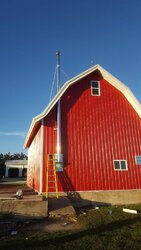
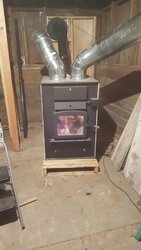
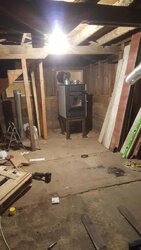



Last edited by a moderator:
Ok I'm going on my second winter with the tundra. Last year I had poor results but mostly I believe because of the chimney. I had a 8x11 flu which I learned was far to big. Since then I installed a 6" round flexible stainless liner with a barometric damper, purchased a manometor and set the draft to .04 to .06 depending on the wind. However I have still been concerned on how hot I can get the stove before being concerned of overfiring. I have been running it manually with the switch, and like other people I am sick of running up and down the stairs trying to warm up the house. So today is the first day I called drolet, and told the gentleman I wanna know how hot can I SAFELY run the stove. He told me hook it up to a thermostat and basically set it and forget it. I explained to him that if I light a fire and my house is 64 degrees and I set the thermostat at 70 or 72, the stove is gonna run for quite a while and probably hit the high limit switch multiple times trying to get to temp. He said that the stove will SAFELY open and close the damper as needed and no need to be concerned. I would appreciate some thoughts on his advice from people that have some good experience with the furnace. Thanks
DoubleB
Minister of Fire
Has anyone else put one of these in an outbuilding or shop?
Welcome to hearth JustinE!
@3fordasho has two Tundras, one is in a shop, somewhere around page 15 of this thread.
That's a sharp looking building you have. The nice thing about your install is that is appears relatively easy to run more ductwork if you find you have a cold spot. So, if you think the downstairs will be warm enough with just radiant from the furnace, then I'd start with simply ducts to the (much larger) 2nd floor. If you find you want a little extra heat downstairs, it looks pretty easy to put a T in one or both of your 8" outlets to run one or two 6" ducts somewhere downstairs.
DoubleB
Minister of Fire
He told me hook it up to a thermostat and basically set it and forget it.
I say BS. SBI is great, but this is the stuff that frustrates me. If you get cracking, SBI will say you abused your furnace and installed it incorrectly.
I explained to him that if I light a fire and my house is 64 degrees and I set the thermostat at 70 or 72, the stove is gonna run for quite a while and probably hit the high limit switch multiple times trying to get to temp.
Your thinking is exactly right, and from our experience is what can get your furnace in trouble. I'd estimate that if open damper is 100% heat and high cracking risk over time, that closed damper is 75% heat with much half the wood and lower cracking risk over time. My approach, both to conserve wood and my furnace, was to observe the furnace at peak burn with the damper closed, then add overtemp protection at a setpoint that would close the damper if it was opened for just a couple minutes. No need to get any hotter. That's a backdoor way of finding a max allowable temp--I just defined my own based upon what I didn't need to exceed and what I knew wasn't too far hotter than typical damper closed.
Don't be intimidated by an overtemp system. You could do a controller like @3fordasho mentions above in post#1663. You could alternatively do snap discs like mine on page 46, which doesn't require electronics know-how (although is not as precise).
You can also see page 45 for SBI's description of safe operating temperatures, but there are many variables and you might be skeptical.
Last edited:
TDD11
Member
Ok thank you. I sent you a PM by the way.Welcome @TDD11 You'll be fine with a Tundra. After you have it for a while you will learn how to load (size) according to heat demand and how to use soft and hardwoods to satisfy light and heavy heat loads.
Not really a minimum height per say other than you need enough height to maintain a minimum rise to your run if you have very much horizontal stove pipe (the less the better, and the steeper the better) IIRC it is 1" rise per foot of run with 10' being the maximum run. Even this would be highly discouraged as it will probably perform poorly. Ideally you would be able to place the furnace so that you could put a 45* elbow on the back of the unit which runs straight to a 45* elbow at the chimney. Or even better, a 90* elbow at the back of the Tundra and then straight up into an internal class A chimney
I believe I will run a 90 out the back of the stove, a very short section of vertical pipe depending on the radius of the 90, and then another 90 into the thimble.
Did you ever measure your draft with this setup? I'm curious, is it as others have mentioned, just not enough heat from the Tundra to get a good draft?Ok I'm going on my second winter with the tundra. Last year I had poor results but mostly I believe because of the chimney. I had a 8x11 flu which I learned was far to big.
Got to thinking about this more, I have seen some stoves that state a minimum vertical rise before going horizontal...its something like 18"-24" IIRC. But I've never seen any spec like that on any wood furnace that I can remember. Probably because furnaces usually go in the basement and have tall chimneys with strong draft.What is the minimum height rise of the flue to the chimney? I thought there was a minimum vertical height
@DoubleB took the words right outta my mouth when I read this, BS! Somewhere in this thread I believe I copied and pasted the email that SBI sent me saying that this...So today is the first day I called drolet, and told the gentleman I wanna know how hot can I SAFELY run the stove. He told me hook it up to a thermostat and basically set it and forget it
...was the reason that the Tundras were cracking... basically said people were running the bag off of 'em. I'll see if I can find it.if I light a fire and my house is 64 degrees and I set the thermostat at 70 or 72, the stove is gonna run for quite a while and probably hit the high limit switch multiple times trying to get to temp
Last edited:
OK, here it is, I thought I posted this before but apparently not. I copied this directly from the email from them. Notice the 4th and 6th line...sounds like just the opposite of what they told @Craig9702 !
"Hello,
Some people did have a problems with their furnace, but what they do not tell is the way it has been installed or used.
WE found that most of problems occurred when the installation is not meeting the minimum requirements of the owner’s manual.
Having the proper air distribution, having the proper static pressure in the ducts, having the proper chimney size, length and ‘’draft’’.
Making sure that the air damper is not staying open from the time you load until the combustion is over.
Making sure that the blower is set the proper way and in operation.
This furnace is a good residential furnace not built to heat a commercial place, not build to heat a garage also serving a house and run at full blast all the time.
There are many reasons why these furnaces have had problems.
For the very most of the time the root case was determined to be a bad installation, or usage."
"Hello,
Some people did have a problems with their furnace, but what they do not tell is the way it has been installed or used.
WE found that most of problems occurred when the installation is not meeting the minimum requirements of the owner’s manual.
Having the proper air distribution, having the proper static pressure in the ducts, having the proper chimney size, length and ‘’draft’’.
Making sure that the air damper is not staying open from the time you load until the combustion is over.
Making sure that the blower is set the proper way and in operation.
This furnace is a good residential furnace not built to heat a commercial place, not build to heat a garage also serving a house and run at full blast all the time.
There are many reasons why these furnaces have had problems.
For the very most of the time the root case was determined to be a bad installation, or usage."
Lcback
Feeling the Heat
Guy988G
New Member
Well update on the crack in my heatmax. I herd back from them today.
Have to take three pics of the inside of the firebox.
Take pics of the install with measurements.
Fill out a three page inspection packet.
And more pics of the crack and area surrounding it.
And proof of purchase even though I have sent it to them once already when I found that they wired the entire furnace backwards.
Sent from my VS880PP using Tapatalk
Have to take three pics of the inside of the firebox.
Take pics of the install with measurements.
Fill out a three page inspection packet.
And more pics of the crack and area surrounding it.
And proof of purchase even though I have sent it to them once already when I found that they wired the entire furnace backwards.
Sent from my VS880PP using Tapatalk
Similar threads
- Replies
- 15
- Views
- 17K


